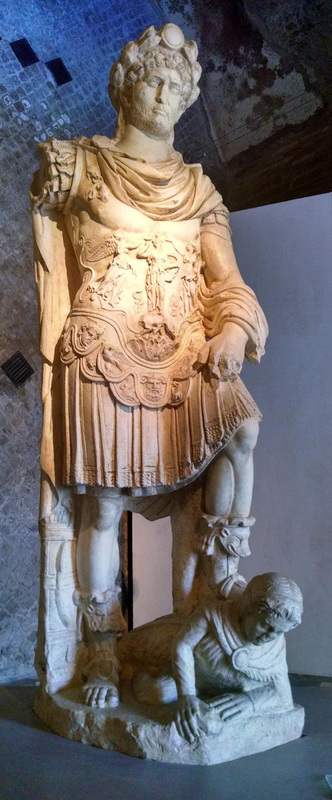Hierapytna Hadrian
Title
Hierapytna Hadrian
Date
120-125 CE Antonine Period
Artist or Workshop
Unknown
Materials
Marble
Height of the work
268 cm
Provenience
Hierapytna – on the island of Crete, Greece
Current Location
Archaeological Museum, Istanbul, Turkey
Description and Significance
Description:
The portrait statue of Hadrian as imperator is an over life-size statue of the emperor, who is standing with his left foot on the back of a fallen barbarian. His right arm is missing while his left arm is resting on the left leg – the same leg pinning the barbarian to the ground with his military open-toed boots. He has a beard with a serious look upon his middle-aged face. On his head is a large corona triumphalis with an elaborate jewel set into the center. On his body, he is wearing a cuirass with his paludamentum tied around his shoulder, and his breastplate depicts some key individualizing features. The cuirass itself has four major features: in the center is an armed statue of Athena, who is being crowned with wreaths on both sides by two winged Victories. Athena is standing on the back of a headless Capitoline she-wolf who is feeding both Romulus and Remus.
Significance:
Hadrian, like Trajan before him, is yet another ruler who does not age in his portraits. He seems to have picked an age (forty years old) for his portraits and stuck with it. The depiction of Hadrian standing over a downtrodden Dacian barbarian is significant since it is perhaps a literal representation of conquest. In this instance, it is a metaphor for stepping on a conquered population. This is a very clear illustration of Hadrian’s accomplishments as a military commander. Hadrian’s military accomplishments are further exemplified in the figural decoration of his cuirass because it expresses Hadrian’s political philosophy. The scene can be interpreted as the triumph of Graeco-Roman civilization over the barbarian world outside the borders of the Roman Empire. In this case, Athena (symbolizing Athens) is standing on the back of the she-wolf who suckles Romulus and Remus (Rome). The Victories in the scene symbolize military victory (conquest style victory). From this depiction, it can be interpreted that Rome is essentially propping up the Greek world; the once great Greek world is now reliant on Rome for its sustenance and power since Rome is now the foundation in this united ideal. Hadrian’s own outlook on the empire is showcased on his cuirass, giving the revival of the glory that was once Classical Greece. It is also important to note that the imagery of this cuirass is so thoroughly identified with Hadrian that even when a headless statue depicting the same scene was discovered in the past, it was confidently identified as a portrait statue of Hadrian.
The portrait statue of Hadrian as imperator is an over life-size statue of the emperor, who is standing with his left foot on the back of a fallen barbarian. His right arm is missing while his left arm is resting on the left leg – the same leg pinning the barbarian to the ground with his military open-toed boots. He has a beard with a serious look upon his middle-aged face. On his head is a large corona triumphalis with an elaborate jewel set into the center. On his body, he is wearing a cuirass with his paludamentum tied around his shoulder, and his breastplate depicts some key individualizing features. The cuirass itself has four major features: in the center is an armed statue of Athena, who is being crowned with wreaths on both sides by two winged Victories. Athena is standing on the back of a headless Capitoline she-wolf who is feeding both Romulus and Remus.
Significance:
Hadrian, like Trajan before him, is yet another ruler who does not age in his portraits. He seems to have picked an age (forty years old) for his portraits and stuck with it. The depiction of Hadrian standing over a downtrodden Dacian barbarian is significant since it is perhaps a literal representation of conquest. In this instance, it is a metaphor for stepping on a conquered population. This is a very clear illustration of Hadrian’s accomplishments as a military commander. Hadrian’s military accomplishments are further exemplified in the figural decoration of his cuirass because it expresses Hadrian’s political philosophy. The scene can be interpreted as the triumph of Graeco-Roman civilization over the barbarian world outside the borders of the Roman Empire. In this case, Athena (symbolizing Athens) is standing on the back of the she-wolf who suckles Romulus and Remus (Rome). The Victories in the scene symbolize military victory (conquest style victory). From this depiction, it can be interpreted that Rome is essentially propping up the Greek world; the once great Greek world is now reliant on Rome for its sustenance and power since Rome is now the foundation in this united ideal. Hadrian’s own outlook on the empire is showcased on his cuirass, giving the revival of the glory that was once Classical Greece. It is also important to note that the imagery of this cuirass is so thoroughly identified with Hadrian that even when a headless statue depicting the same scene was discovered in the past, it was confidently identified as a portrait statue of Hadrian.
References
Future Learn Website:
https://www.futurelearn.com/courses/hadrians-wall/0/steps/5086
Kleiner, Diana E. E. Roman Sculpture. Yale UP, 1994, 241. Print.
Research Gate Website:
https://www.researchgate.net/publication/296324135_Bar_Kokhba_and_the_panhellenion_The_statue_of_hadrian_wearing_armour_from_HierapytnaCrete_Istanbul_archaeological_museum_inv_no_50_and_the_cuirassed_torso_inv_no_8097_in_the_piraeus_archaeological_Mus
University of Libraries Website:
http://digital.library.louisville.edu/cdm/ref/collection/vrc/id/1167
https://www.futurelearn.com/courses/hadrians-wall/0/steps/5086
Kleiner, Diana E. E. Roman Sculpture. Yale UP, 1994, 241. Print.
Research Gate Website:
https://www.researchgate.net/publication/296324135_Bar_Kokhba_and_the_panhellenion_The_statue_of_hadrian_wearing_armour_from_HierapytnaCrete_Istanbul_archaeological_museum_inv_no_50_and_the_cuirassed_torso_inv_no_8097_in_the_piraeus_archaeological_Mus
University of Libraries Website:
http://digital.library.louisville.edu/cdm/ref/collection/vrc/id/1167
Contributor
Ryan Tetter
Citation
Unknown, “Hierapytna Hadrian,” Digital Portrait "Basket" - ARTH488A "Ancient Mediterranean Portraiture", accessed June 6, 2025, http://classicalchopped.artinterp.org/omeka/items/show/47.
Item Relations
This item has no relations.

